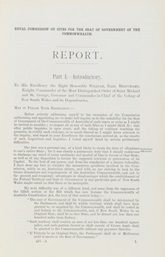| >20,000 years ago |
Indigenous country
|
|
|
|
For more than 20,000 years Indigenous people have been the traditional custodians of the region known as the Australian Capital Territory, including the hill on which Parliament House now sits. This is reflected in the fact that, since 2010, the Presiding Officer in the Senate and House of Representatives[1] respectively begins each sitting day with prayers and an acknowledgement of the traditional Indigenous custodians of the Canberra area, the Ngunnawal and Ngambri peoples.[2] Indigenous people have continued to live in the region and maintain a strong sense of identity and connection with the land.
|
Watch: Acknowledgement of country, House of Representatives, 12 March 2013
Video courtesy of DPS Broadcasting, Parliament House
Watch: Acknowledgement of country, Senate, 12 March 2013
Video courtesy of DPS Broadcasting, Parliament House
|
| 1825‒6 |
European occupation
|
|
|
|
European settlers begin settling the area known as the 'Limestone Plains' following the first recorded visit to the area by Charles Throsby Smith, Joseph Wild and James Vaughan in 1820.
Joshua John Moore is recorded as the first European landowner in the area known as the Limestone Plains. On 21 October 1824 he takes out a ticket-of-occupation for 2000 acres on what is to become the site of Canberra. In 1825 he obtains permission to purchase 1000 acres of unoccupied land, but does not exercise his option to purchase until 16 December 1826 when he writes:
The land I wish to purchase is situate at Canbery on the E. bank of the river which waters Limestone Plains, above its junction with the Murrumbeeja [sic], adjoining the grant of Mr Robert Campbell snr. [3]
|
|
|
1826‒
1900
|
From Limestone Plains to Canberra |
|
|
|
Settlers establish large pastoral properties, small farming enterprises and villages on the Limestone Plains and, by the mid-nineteenth century, the district is being referred to as Canberra. European occupation, here as elsewhere in south-eastern Australia, has a major impact on the Indigenous people of the Canberra region.
|
|
| 1890s |
Australasian Federal Conventions
|
|
|
|
During the 1890s, a series of conventions develop the basis for the federation of Australia.
In 1890, leading politicians from the six Australian colonies and New Zealand attend the Australasian Federation Conference in Melbourne and agree to 'an early union under the crown'. In 1891 members of the National Australasian Convention meet in Sydney to debate how the colonies should federate and to develop a draft constitution. The Australasian Federal Convention meets in three sessions in 1897 and early 1898 to modify the 1891 draft. The Constitution contained in the Commonwealth of Australia Constitution Bill is subsequently endorsed by voters of each Australian colony at referendums held in 1898, 1899 and 1900, and is passed by the British Parliament and given Royal Assent on 9 July 1900. [4]
|

The Australasian Federation Conference delegates, Melbourne, February 1890. Photographer: Johnstone, O’Shannessy & Co
Image courtesy of National Archives of Australia |
| 1899 |
The first Royal Commission to determine a site
|
|
| |
The NSW Government appoints a royal commission to inquire into suitable sites for the federal capital. Commissioner Alexander Oliver presents his report in October 1990 recommending Bombala-Eden, Orange and Yass.[5]
|

Report of the Commissioner on Sites for the Seat of Government of the Commonwealth, NSW Government, 30 October 1900
Image courtesy of National Archives of Australia
|